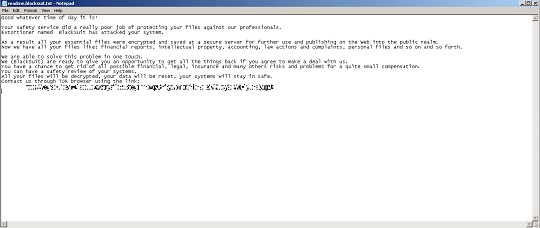Ransom.Win32.BLACKSUIT.YPDJB
Trj/RansomGen.A (PANDA)
Windows


Threat Type: Ransomware
Destructiveness: No
Encrypted: Yes
In the wild: Yes
OVERVIEW
This Ransomware arrives on a system as a file dropped by other malware or as a file downloaded unknowingly by users when visiting malicious sites.
It drops files as ransom note. It avoids encrypting files with the following file extensions.
TECHNICAL DETAILS
Arrival Details
This Ransomware arrives on a system as a file dropped by other malware or as a file downloaded unknowingly by users when visiting malicious sites.
Installation
This Ransomware adds the following processes:
- vssadmin delete shadows /all /quiet → used to delete shadow copies
- ping 1.1.1.1 -n 3 -w 5000
It adds the following mutexes to ensure that only one of its copies runs at any one time:
- Global\WLm87eV1oNRx6P3E4Cy9
Information Theft
This Ransomware gathers the following data:
- OS Version
- Username
- Hostname
- Number of Processors
- Disk Information
Other Details
This Ransomware does the following:
- It encrypts fixed drives, removable drives, and network shares.
It accepts the following parameters:
- Required to proceed to its encryption routine:
- -id {victim ID}
- -path {target path} → specify directory to encrypt
- -ep → define encryption parameter
- -vmonly → encrypt all files
- -logs → display terminal logs
- -stopvm → terminates VM processes
- -fork → creates a child process of itself
Ransomware Routine
This Ransomware avoids encrypting files with the following strings in their file name:
- bootsect.bak
- autorun.inf
- iconcache.db
- thumbs.db
- ntuser.ini
- boot.ini
- bootfont.bin
- ntuser.dat
- ntuser.dat.log
- ntldr
- desktop.ini
- readme.blacksuit.txt
It appends the following extension to the file name of the encrypted files:
- {Original filename}.{Original extension}.blacksuit
It drops the following file(s) as ransom note:
- {All available drives}\readme.blacksuit.txt
- {Encrypted directory}\readme.blacksuit.txt
- {malware path}\readme.blacksuit.txt

It avoids encrypting files with the following file extensions:
- com
- ani
- scr
- drv
- hta
- rom
- bin
- msc
- ps1
- diagpkg
- shs
- adv
- msu
- cp
- prf
- bat
- idx
- mpa
- cmd
- msi
- mod
- ocx
- icns
- ics
- sp
- 386
- lock
- sys
- rtp
- wpx
- diagcab
- theme
- deskthemepack
- msp
- cab
- ldf
- nomedia
- ic
- lnk
- cur
- dll
- nls
- themepack
- msstyles
- hlp
- key
- ico
- exe
- diagcfg
- blacksuit
SOLUTION
Step 1
Trend Micro Predictive Machine Learning detects and blocks malware at the first sign of its existence, before it executes on your system. When enabled, your Trend Micro product detects this malware under the following machine learning name:
- Troj.Win32.TRX.XXPE50FFF073
Step 2
Before doing any scans, Windows 7, Windows 8, Windows 8.1, and Windows 10 users must disable System Restore to allow full scanning of their computers.
Step 3
Note that not all files, folders, and registry keys and entries are installed on your computer during this malware's/spyware's/grayware's execution. This may be due to incomplete installation or other operating system conditions. If you do not find the same files/folders/registry information, please proceed to the next step.
Step 4
Search and delete these files
- {All available drives}\readme.blacksuit.txt
- {Encrypted directory}\readme.blacksuit.txt
- {malware path}\readme.blacksuit.txt
Step 5
Scan your computer with your Trend Micro product to delete files detected as Ransom.Win32.BLACKSUIT.YPDJB. If the detected files have already been cleaned, deleted, or quarantined by your Trend Micro product, no further step is required. You may opt to simply delete the quarantined files. Please check the following Trend Micro Support pages for more information:
Step 6
Restore encrypted files from backup.
Did this description help? Tell us how we did.

